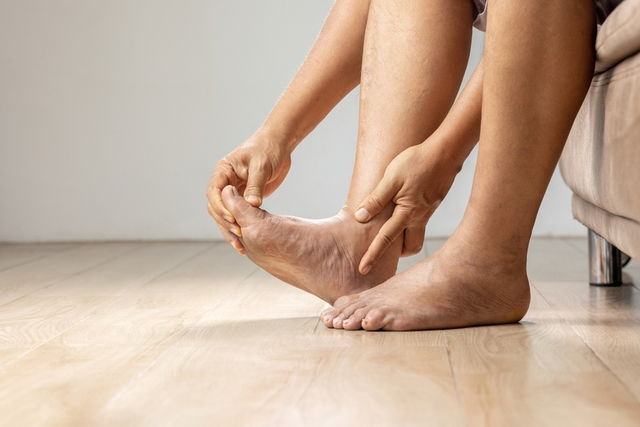Swollen legs can occur as a result of chronic diseases, pregnancy, medication use, thrombosis, arthritis, infectious cellulitis, direct blow, prolonged sitting or standing, or normal aging.
Cases of swollen legs that are associated with other symptoms, like intense pain or difficulty moving the legs, should be assessed by a doctor. These may be a sign of a health condition that requires treatment.
Treatment for swollen legs depends on the underlying cause. The doctor may prescribe specific medication and/or recommend lifestyle changes as well as compression socks.

Main causes
The most common causes of swollen legs are:
1. Prolonged sitting or standing
Standing or sitting for many consecutive hours, especially sitting with your legs crossed, can interfere with blood flow in the legs and make it more difficult for blood to return to the heart. This leads to the accumulation of blood in the legs, causing swelling as the day goes on.
What to do: Avoid sitting or standing for more than 2 hours, making sure to take breaks to stretch and move. At the end of the day, you can massage the legs and elevate them above heart level to promote optimal circulation.
2. Pregnancy
Pregnancy is one of the main causes of swollen legs in women between 20 and 40 years old. Pregnancy is associated with increased overall blood volume in the body, and the growing uterus can also interfere with circulation to the legs. Both of these factors contribute to blood accumulating in the legs, which is most pronounced after the fifth month of pregnancy.
What to do: Women are advised to use compression stockings and to take short walks throughout the day to promote blood circulation. When sitting or lying down, legs should be elevated on a pillow or stool.
3. Aging
Swollen legs are most frequently noted in older adults, as aging can cause blood vessel valves to become weaker and make blood return more difficult. This leads to the accumulation of blood in the legs.
What to do: Patients are advised to avoid standing or sitting for prolonged intervals, and to take pauses to elevate the legs when possible. Very severe swelling should be assessed by a doctor to investigate for other underlying causes, like hypertension. If necessary, the doctor may prescribe medication, like furosemide, to help eliminate excessive fluid.
4. Medication use
Some medications, like the birth control pill, diabetes medicine, antihypertensives, pain meds and hormone replacement therapy can cause water retention, leading to swollen legs.
What to do: You are advised to see your prescriber to determine whether the swollen legs are related to the treatment. The doctor may consider discontinuing the medication or swapping for an alternative. If the swollen legs persist, you should follow-up with a prescriber again.
5. Chronic diseases
Some chronic diseases, like heart failure, kidney problems and liver disease can cause changes to blood circulation, leading to swollen legs.
What to do: You should consult a family doctor if you notice other symptoms, like excessive fatigue, changes to blood pressure, urinary changes or abdominal pain. The doctor will assess these symptoms and determine a diagnosis to start treatment, which should help with the swelling.
6. Deep vein thrombosis (DVT)
A thrombosis in the lower extremities can occur at any age, but it is more common in older adults and patients with a positive family history of this condition. It can be triggered by other factors, however, like having other clotting problems, prolonged sitting or standing, smoking, pregnancy or even birth control use.
DVTs cause sudden swelling in one leg, as well as intense pain, difficulty moving the affected leg and redness.
What to do: You are advised to proceed to the closest hospital for assessment. The doctors will order testing to determine the cause of the thrombosis and initiate treatment promptly to prevent complications.
7. Direct trauma
Direct trauma to the legs, which can occur with falling or taking a kick to the legs when playing soccer, for example, can rupture small blood vessels in the legs, leading to swelling. In these cases, swelling is accompanied by intense pain, bruising, redness and heat.
What to do: You should apply a cold compress to the affected area to reduce swelling and pain. If pain does not improve or resolve within a week, you should see a doctor for further assessment.
8. Arthritis
Arthritis is an inflammation of the joints that is most common in older adults. It can cause swelling in the legs, especially areas that have joints, like the knee, ankle or hip. Other symptoms include pain, deformity and difficulty moving.
What to do: You can apply a topical anti-inflammatory to relieve swelling and pain, but you should ideally consult a rheumatologist to diagnose the issue and start appropriate treatment. The doctor may prescribe medication, physiotherapy, or in severe cases, surgery.
9. Infectious cellulitis
Infectious cellulitis is an infection that affects the deepest layer of skin, and is most caused by an infected wound that is left untreated. When skin in the legs becomes infected, it can cause swollen legs, intense redness, fever over 100ºF (or 38ºC) and intense pain. Learn more about what causes cellulitis and the treatment options available.
What to do: You should proceed to the closest hospital if symptoms persist for over 24 hours. A confirmed diagnosis will often be treated with IV antibiotics.
